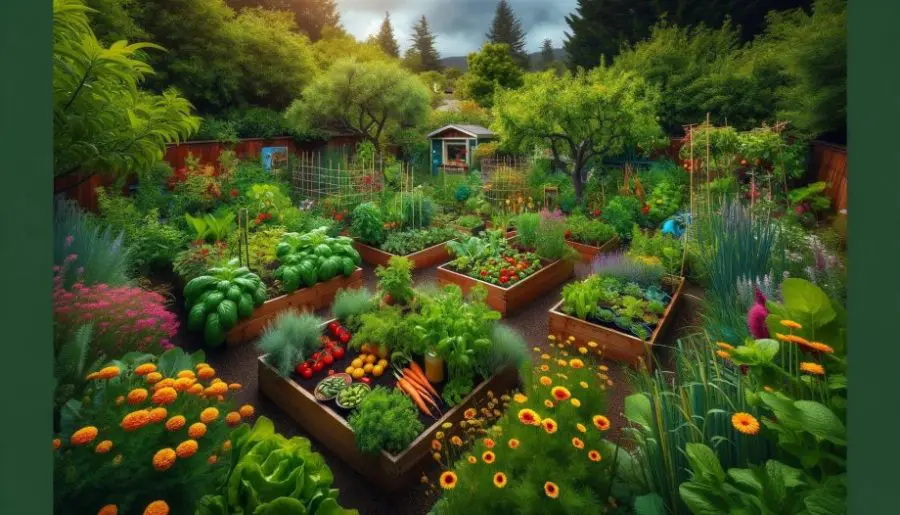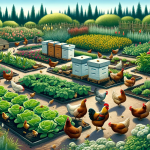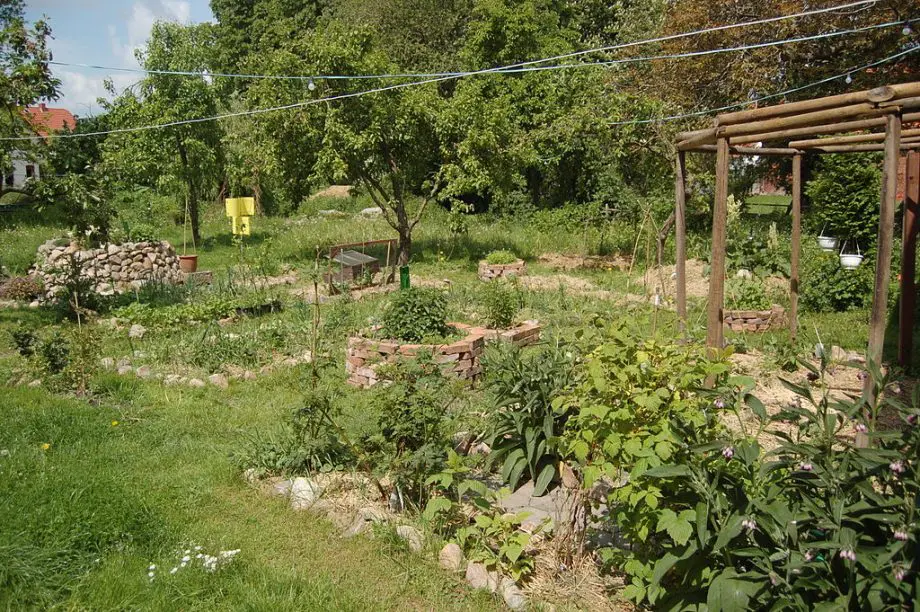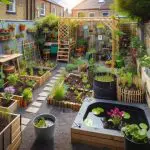
Dive into backyard permaculture! Learn easy tips to transform your outdoor space into a sustainable, eco-friendly haven, right at your doorstep.
Backyard Permaculture Key Takeaways:
- Backyard permaculture is a sustainable gardening method that mimics natural ecosystems.
- It involves designing your garden to create a self-sufficient, biodiverse environment, utilizing natural resources and reducing waste.
- This approach fosters a harmonious balance with nature in your backyard.
Ever dreamed of turning your backyard into a vibrant ecosystem? Welcome to the world of backyard permaculture!
It’s all about harmonizing with nature, using simple techniques to create a self-sustaining garden that benefits both you and the environment.
Let’s embark on this green journey together!
Introduction to Backyard Permaculture
Understanding the Basics of Backyard Permaculture
Backyard permaculture transforms your garden into a self-sustaining ecosystem, mimicking natural systems.
It emphasizes harmonizing with the local environment, using native plants and organic matter to improve soil quality.
This method is not just a gardening technique; it’s a philosophy for creating a natural ecosystem right in your home gardens.
1. Permaculture Principles: The Foundation of Backyard Ecosystems
-
- Understanding Permaculture Principles: Permaculture principles offer a framework for sustainable living and gardening. They focus on working with, rather than against, natural systems.
- By observing and replicating natural ecosystem processes, permaculture gardening aims to create a harmonious balance in home gardens, enriching both the land and our lives.
- Applying Principles to Garden Design: The first step in backyard permaculture design is to integrate these principles into your garden space. This involves considering factors like local climate, soil quality, and available space.
- Utilizing techniques like companion planting, creating food forests, and employing organic practices, permaculture transforms your garden into a thriving, low-maintenance ecosystem.
- Designing your garden in this way not only benefits beneficial insects and local wildlife but also enhances soil health and helps in effective water and energy storage, crucial for sustaining the garden through all seasons.
2. Selecting Native Plants for Permaculture Gardens

-
- Importance of Native Plants: Native plants are central to permaculture gardening. They are naturally adapted to the local environment, requiring less water and maintenance, and contributing to soil health.
- Native plants support local ecosystems, providing habitat and food for beneficial insects and wildlife. Integrating native plants into your garden fosters a natural ecosystem that thrives with minimal human intervention.
- Choosing the Right Plants for Your Garden: When selecting native plants for your permaculture garden, consider factors like the local climate, soil type, and the amount of space available.
- Some native plants may be better suited for container gardens or small spaces, while others thrive in larger garden areas. Incorporate a variety of plants, including tall trees, shrubs, and groundcovers, to create a diverse and resilient garden.
- In permaculture, every plant serves a purpose, whether it’s fixing nitrogen in the soil, providing shade, or offering food sources for wildlife.
Here is a table showing a variety of plants suitable for a permaculture backyard, including vegetables, herbs, flowers, fruit trees, and native plants:
| Vegetables | Herbs | Flowers | Fruit Trees | Native Plants | |
|---|---|---|---|---|---|
| 1 | Tomatoes | Basil | Marigolds | Apple | Wildflowers |
| 2 | Carrots | Mint | Nasturtiums | Pear | Grasses |
| 3 | Lettuce | Rosemary | Sunflowers | Cherry | Ferns |
| 4 | Zucchini | Thyme | Lavender | Plum | Shrubs |
| 5 | Spinach | Cilantro | Calendula | Peach | Trees |
This selection includes a mix of plants that can contribute to a diverse and thriving permaculture garden, each fulfilling different roles in the ecosystem
3. Creating a Natural Ecosystem with Permaculture Techniques
-
- Emulating Natural Systems: In permaculture gardening, replicating natural systems is a key concept. This involves observing how elements in nature interact and mimicking these patterns in your garden.
- By creating a mini-ecosystem, you can achieve a self-regulating garden. This includes using organic matter like dead leaves and wood chips to enrich the soil, practicing sheet mulching to prevent soil erosion, and establishing rain gardens to manage water runoff.
- These practices foster a natural balance, promoting healthy plant growth and reducing the need for artificial inputs.
- Integrating Wildlife and Human Interaction: A successful permaculture garden is one that invites and sustains wildlife. Providing a water source, such as a small pond or rain barrels, attracts birds and beneficial insects, enhancing biodiversity.
- Including plants like tall trees and shrubs create a habitat for various species. Additionally, designing garden spaces for human interaction, like seating areas or paths, allows for a deeper connection with nature.
- Permaculture techniques like these not only benefit the natural world but also enrich our personal experience of the garden, making it a great place for relaxation and observation.
4. The Practicalities of Permaculture: Store Energy and Maintain Soil Health
- Storing Energy in the Garden: Storing energy is a fundamental permaculture principle. This can be achieved through strategies like capturing rainwater in barrels for irrigation or using the thermal mass of rocks to regulate temperature.
- These techniques help to create a closed-loop system, where resources are utilized efficiently.
- In terms of food production, permaculture gardens often include perennial plants and fruit trees, like dwarf fruit trees and berry bushes, which provide food sources over multiple seasons.
- This approach ensures a sustainable supply of homegrown food throughout the year.
- Improving and Maintaining Soil Health: Soil health is the cornerstone of a productive permaculture garden. Incorporating organic materials such as compost, leaf litter, and green waste into the soil improves its structure and fertility.
- Practices like composting kitchen scraps and garden waste transform organic matter into valuable compost, enriching the soil. Companion planting and crop rotation further enhance soil quality by preventing nutrient depletion and soil compaction.
- Moreover, utilizing natural pest control methods, such as encouraging predator insects or using companion plants as natural repellents, maintains a healthy balance in the garden, reducing the need for chemical interventions.
5. Maximizing Garden Space: Permaculture in Small and Urban Areas

-
- Permaculture in Limited Spaces: Permaculture principles can be adapted to small gardens and even urban settings, like balconies or rooftop gardens. Container gardens and vertical gardening are great ways to maximize limited space.
- Using techniques such as trellising for climbing plants or installing wall planters can turn a small space into a productive garden. In urban areas, community gardens offer an opportunity for practicing permaculture principles and sharing knowledge.
- These gardens not only provide fresh, organic food but also serve as green spaces for community engagement and education.
- Urban Permaculture Techniques: Urban permaculture focuses on making the most of available space and resources. Rain barrels for water conservation, compost bins for organic waste recycling, and container gardens for growing food are some of the easy ways to implement permaculture in an urban setting.
- Greywater systems can be installed to reuse household water for irrigation. Creating an edible landscape with a variety of plants, including herbs, leafy greens, and dwarf fruit trees, not only adds beauty but also serves a practical purpose.
- In big cities, rooftop and balcony gardens can become mini-ecosystems, providing a habitat for beneficial insects and contributing to local biodiversity.
6. Permaculture Through the Seasons: Adapting to the Climate
- Seasonal Adaptation in Permaculture: Permaculture gardening is about understanding and adapting to the local climate and seasonal changes. In the winter months, practices like mulching with straw or leaves help protect the soil and retain moisture.
- Growing cold-hardy crops and using greenhouses or cold frames can extend the growing season. In the summer, techniques like shading and mulching help conserve water and protect plants from heat stress.
- Planting a variety of crops ensures a continuous harvest throughout the year, aligning with the natural rhythm of the seasons.
- Climate-Resilient Gardening: Climate-resilient gardening involves selecting plants that are well-suited to the local environment and can withstand climate extremes.
- This includes choosing drought-tolerant species for arid climates or water-loving plants for wetter areas. Designing the garden layout to optimize sun exposure in the winter and shade in the summer also plays a crucial role.
- By observing and responding to the local climate, permaculture gardeners can create gardens that are both productive and resilient, capable of adapting to changing environmental conditions.
Gaia’s Garden: A Guide to Home-Scale Permaculture
7. Example Projects and Outcomes

Backyard permaculture can yield transformative results. For instance, consider a project where a barren backyard was turned into a vibrant food forest.
By utilizing permaculture principles, the space now provides a variety of fruits, vegetables, and herbs.
Key outcomes included improved soil quality, increased biodiversity, and a self-sustaining ecosystem.
Another notable example is the transformation of a small urban yard into a permaculture haven with raised beds, a rain garden, and native plants.
This not only enhanced the aesthetic appeal but also served as a model for sustainable urban gardening, showcasing efficient water usage and a significant increase in local pollinators.
Personal Backyard Permaculture Design Experiences
My journey to design a permaculture backyard began with a simple herb garden.
Over time, it evolved into an integrated system featuring companion planting, a small pond for wildlife, and a composting setup. The experience was enlightening, demonstrating how small changes can create a big impact on the local ecosystem.
Another personal project involved converting a lawn into a food-producing landscape.
This not only reduced water consumption but also provided fresh, organic produce.
The learning curve was steep, but the satisfaction of creating a sustainable, productive space was unparalleled.
Backyard Permaculture FAQs
Q: How do I permaculture my backyard?
A: Begin by observing your yard to understand its unique characteristics. Apply permaculture principles like diversity, efficient energy use, and stacking functions. Start with small projects like composting, rainwater harvesting, and planting native species.
Q: How do I convert my backyard to permaculture?
A: Transition gradually. Replace traditional lawns with edible gardens, incorporate companion planting, establish rainwater catchment systems, and enrich your soil with organic matter. Adapt these practices to fit your yard’s specific conditions.
Q: What should be in a permaculture garden?
A: A permaculture garden should include a variety of plants that fulfill different roles, such as food production, attracting pollinators, and improving soil health. It should also integrate sustainable water management and composting systems.
Q: What are the pros and cons of permaculture?
A: Pros include increased biodiversity, sustainable resource use, and self-sufficiency. Cons can be the initial time and effort required to establish the system and the need for ongoing learning and adaptation.
Q: What are the three pillars of permaculture?
A: The three pillars are Earth Care (sustainable land use), People Care (community and personal well-being), and Fair Share (equitable distribution of resources and limits to consumption and reproduction).
Q: What is the difference between homesteading and permaculture?
A: Homesteading is about self-sufficiency, often including farming, while permaculture is a design principle focused on sustainable and regenerative practices. Permaculture can be a part of homesteading.
Q: How much land do you need for permaculture?
A: Permaculture can be adapted to any size of land, from small urban balconies to large rural properties. The principles remain the same, regardless of scale.
Q: How do permaculture farms make money?
A: They can generate income through selling organic produce, offering educational courses, and providing design consultancy services. Diversification and community involvement are key.
Q: What is a holistic permaculture farm?
A: A holistic permaculture farm integrates various elements like crop production, animal husbandry, and water management into a self-sustaining system, considering both the environmental and social aspects.
Q: What is Permafarming?
A: Permafarming is a term often used synonymously with permaculture farming, emphasizing the creation of permanent, sustainable agricultural systems that mimic natural ecosystems.
Q: Is permaculture permanent?
A: While the term ‘permaculture’ suggests permanence, it’s more about creating sustainable and resilient systems that can adapt and evolve over time.
Q: What is another name for permaculture?
A: Permaculture is also referred to as ecological or sustainable agriculture, regenerative design, or simply as sustainable living practices.
Backyard Permaculture Conclusion

Embracing Sustainable Living Through Backyard Permaculture
Embracing sustainable living through backyard permaculture is a transformative journey that brings the principles of ecological balance and resource efficiency right to your doorstep.
This approach to gardening goes beyond traditional practices, integrating the harmony of nature into every aspect of your outdoor space.
By adopting the principles of permaculture, you can turn your backyard into a self-sustaining ecosystem that not only provides fresh, organic produce but also nurtures biodiversity, conserves resources, and fosters a deeper connection with the environment.
This guide has introduced you to the basics of backyard permaculture, offering practical tips and insights to help you embark on this rewarding path toward a more sustainable lifestyle.
A Journey of Learning and Adaptation
Backyard permaculture is more than a gardening approach; it’s a journey towards sustainable living. It requires patience, observation, and a willingness to learn from nature. The transition to a permaculture garden symbolizes a commitment to ecological balance and personal responsibility in environmental stewardship.
The Ripple Effect of Small Changes
Even the smallest permaculture practices can have significant impacts. From nurturing soil health to conserving water, each element contributes to a healthier ecosystem. This ripple effect extends beyond your backyard, influencing the local environment and inspiring community awareness about sustainable practices.
Reaping the Rewards of Permaculture
The rewards of a permaculture garden are abundant. Beyond the tangible yield of fresh, organic produce, there’s the intangible satisfaction of contributing to a healthier planet. It’s about creating a space that nurtures both people and wildlife, fostering a deep connection with the natural world.
The Future of Permaculture
As we look towards the future, permaculture offers a hopeful vision of sustainability and resilience. It’s a dynamic field, continually evolving with new insights and innovations. Embracing permaculture principles in our backyards is a step towards a more sustainable, regenerative future, where humans live in harmony with nature.








